10 – 27 OCTOBER 2022
By Andrew Walker
Overview
This comprehensive New Zealand tour started in Auckland, North Island on the 10th of October 2022 and ended in Dunedin, South Island on the 27th of October 2022. We visited Tawharanui Regional Park, Tiritiri Matangi Island, Pūkorokoro Miranda Shorebird Centre, Pureora Forest Park, Tongariro National Park, Kapiti Island, Blumine Island, Arthur’s Pass National Park, Okarito Lagoon, Mount Aspiring National Park, Tasman Delta, Taiaroa Head, Stewart Island (Rakiura), Ulva Island, Te Anau, Milford Sound, and Homer Tunnel. We also took several pelagic trips, such as at Hauraki Gulf, Queen Charlotte Sound, Kaikoura, Dunedin, and at Stewart Island (Rakiura).
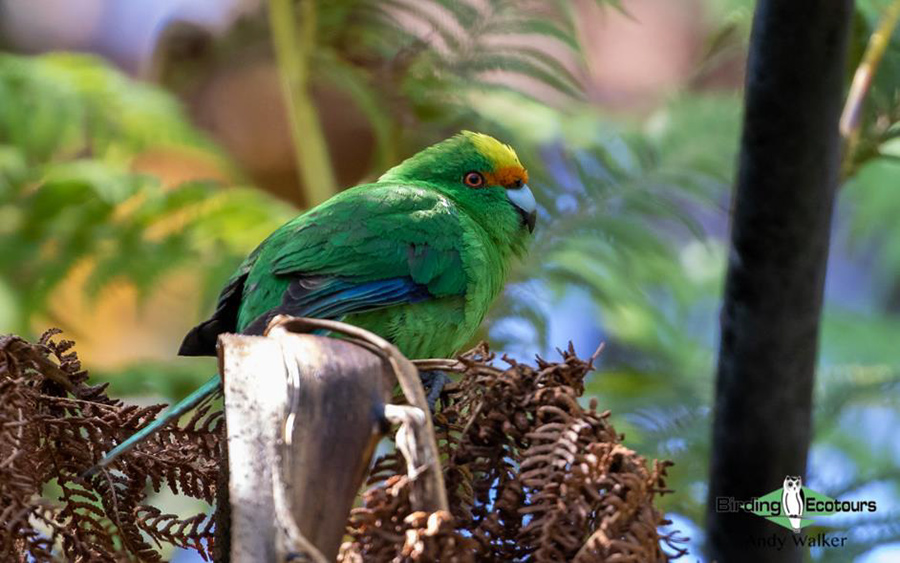
We got some great looks at the Critically Endangered (BirdLife International) Malherbe’s Parakeet during our New Zealand birding tour; this is one of the rarest parrots in the world.
During the tour we recorded numerous New Zealand endemic birds (almost 50 species), highlights included Little Spotted Kiwi, North Island Brown Kiwi, Southern Brown Kiwi, Brown Teal, New Zealand Falcon, Wrybill, Black Stilt, Blue Duck, Malherbe’s Parakeet, New Zealand Kaka, Kea, North Island Saddleback, South Island Saddleback, Stitchbird, Tomtit, Yellowhead, Pipipi, North Island Robin, South Island Robin, New Zealand Rockwren, and Rifleman. Several breeding-endemics were also found, like the stunning Double-banded Plover.
The waters around New Zealand are blessed with huge numbers of incredible seabirds, and it is no surprise that they featured heavily during the tour. Albatrosses, penguins, petrels, cormorants, and shearwaters were recorded in good numbers and diversity and included Buller’s Albatross, Northern Royal Albatross, Cook’s Petrel, New Zealand King Shag, Fiordland Penguin, and Yellow-eyed Penguin to name just a few. New Zealand’s avifauna now also includes introduced species from Europe, Asia, and Australia (some making it under their own steam from the latter region) and many of these were also observed during the tour. Native species, such as Pacific Long-tailed Cuckoo, Shining Bronze Cuckoo, and Sacred Kingfisher were also recorded.
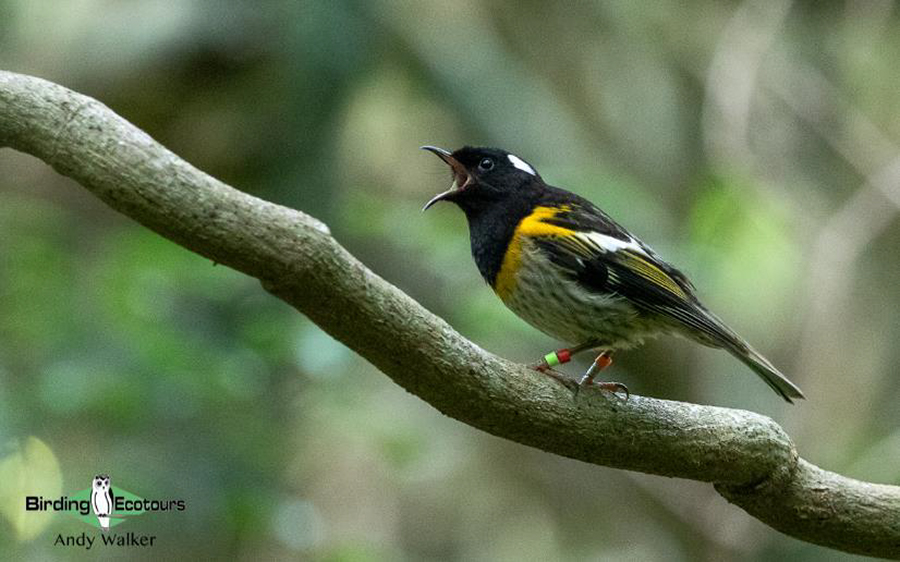
Stitchbird was a highly desired New Zealand endemic bird that gave us some fantastic sightings.
Detailed Report
Day 1, 10th October 2022. Arrival in Auckland and transfer to Warkworth with afternoon birding at Tawharanui Regional Park
The group met in downtown Auckland at lunchtime where we met our excellent local guides Mark and Richard, who would take us on our long and winding journey from northern to southern New Zealand. A few of the group had arrived earlier than the tour start date and had explored Auckland city (including Auckland Zoo) and even made the trip down to Hobbiton to visit the “The Lord of the Rings” and “The Hobbit” film trilogies set!
We drove north out of Auckland city over the harbor bridge, heading towards our quaint accommodation for the first night of the tour in the town of Warkworth, just about an hour north of the city. After a quick check in we drove out to Tawharanui Regional Park where we had some afternoon tea and got our birding underway with a few endemics, such as Brown Teal, Paradise Shelduck, Variable Oystercatcher, New Zealand Pigeon, Tui, Whitehead, Grey Gerygone, and New Zealand Fantail all seen well. More widespread resident and introduced species were also noted, such as Swamp Harrier, Australasian Swamphen (in very high numbers), Sacred Kingfisher, White-faced Heron, Common Myna, Song Thrush, Common Blackbird, Silvereye, and European Goldfinch.
We dropped back into town for dinner and bed, ready for the pelagic the following day.
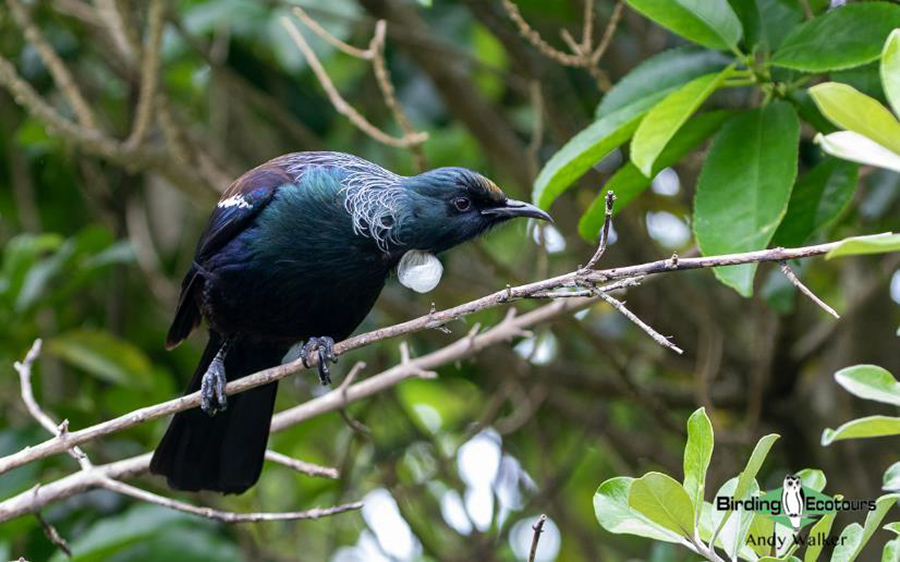
One of the commonest and most widespread of the New Zealand endemics, the Tui is one charismatic and attractive bird, with an incredible vocal repertoire.
Day 2, 11th October 2022. Hauraki Gulf pelagic and Tawharanui Regional Park kiwi trek
We headed into the Hauraki Gulf for our first pelagic trip of the tour. As we left the marina, we noted Silver (Red-billed) Gull, Kelp Gull, Pied Cormorant, African Collared (Barbary) Dove, and White-fronted Tern. As we progressed out to sea, we picked up Fluttering Shearwater, Little Shearwater, Common Diving Petrel, Australasian Gannet, and Bryde’s Whale.
We reached a particular point on our pelagic and started putting the burley (chum) out. It didn’t take too long to pay rewards and soon we had a couple of Flesh-footed Shearwaters coming to the back of the boat, along with Cook’s Petrel, White-faced Storm Petrel, Fairy Prion, Buller’s Shearwater, and Sooty Shearwater. There was excitement when first a Shy (White-capped) Albatross flew in behind the boat, and then shortly afterwards a Salvin’s Albatross flew in too, allowing for comparisons to be made between both species. To top it off we then had a Buller’s Albatross fly in, and this bird would remain with us on and off all day, what a spectacular sight.
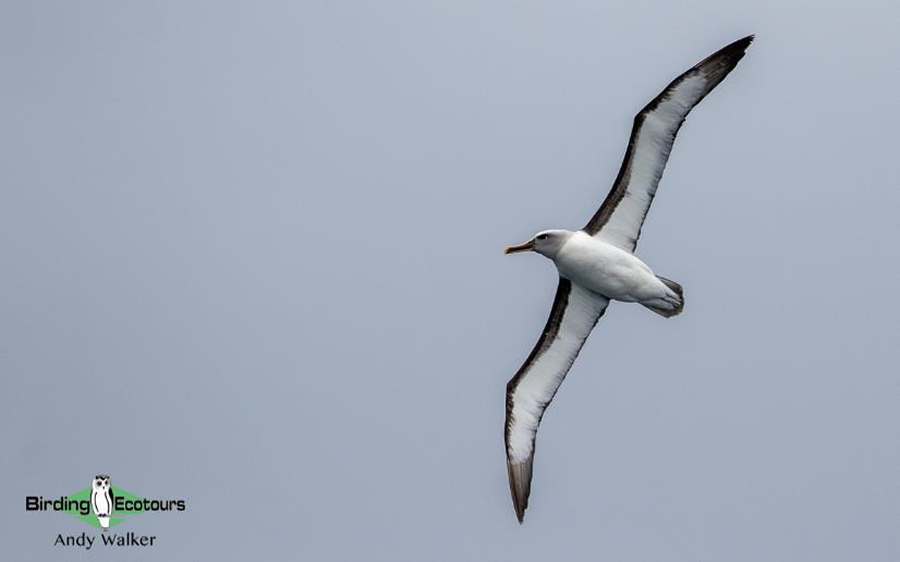
This Buller’s Albatross spent quite a while visiting the boat during the morning and the afternoon. It was very interested in our burley (chum) and an early “bird of the trip” contender!
We took our lunch up close to one of the small islands, so we were out of the wind. While here we picked up a few distant endemic land birds and enjoyed listening to some native New Zealand bird song. As we left the sheltered spot, we soon found a Humpback Whale, which gave some excellent views, as did a Northern Giant Petrel. Our journey back to the harbor was filled with the same species as previously mentioned and better views of some species, such as Fluttering Shearwater. As the tide had dropped, we saw several New Zealand Plovers on the sandflats. In the evening we headed back to Tawharanui Regional Park where saw Morepork (a hawk-owl), and some of the group saw North Island Brown Kiwi during a kiwi walk. We arrived back at our accommodation quite late after a very long, but very rewarding day birding in New Zealand!
Day 3, 12th October 2022. Tiritiri Matangi Island birding
After breakfast we took the short ferry ride across from Gulf Harbour to Tiritiri Matangi Island, a predator-free island that contains many rare New Zealand endemic birds. As soon as we landed we started birding and we walked around the island during the morning and early afternoon. During our time on this beautiful island, we found lots of key target birds, including North Island Kokako and Stitchbird, both were collecting nesting material and showed well. North Island Saddleback, Red-crowned Parakeet, and New Zealand Bellbird gave us some good views too, and we also had our best views so far of endemics like Whitehead and Tui, and we found a roosting Morepork too. Around the coastline of the island, we noted White-fronted Tern, Silver (Red-billed) Gull, Kelp Gull, Paradise Shelduck, and Variable Oystercatcher.
It was also great to hear the bird song here, very few non-native species were present and the song filling the air was pretty much just that of native species, giving a glimpse into the past, and what it must have been like hundreds of years ago before settlement. After an enjoyable day we headed back into Auckland where we spent the night.
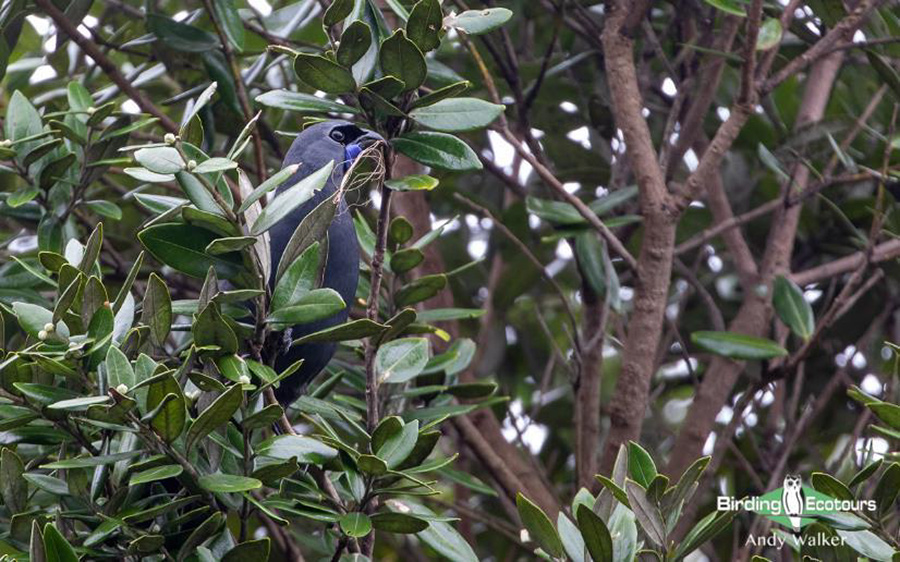
This North Island Kokako was collecting nesting material when we found it.
Day 4, 13th October 2022. Pūkorokoro Miranda Shorebird Centre and travel to Rotorua
Leaving Auckland for the final time we started our journey south through New Zealand. Our first stop was the Pūkorokoro Miranda Shorebird Centre and we then called in to the nearby Piako Floodplain. Both of these sites yielded lots of new birds for the tour and included the endemic and highly sought-after shorebird, Wrybill, along with two breeding-endemics, Double-banded Plover and White-fronted Tern. Other resident birds present include Black-billed Gull, Pied Stilt, South Island Oystercatcher, Variable Oystercatcher, Masked Lapwing, Black Swan, Paradise Shelduck, Grey Teal, Australasian Shelduck, Royal Spoonbill, Caspian Tern, and Swamp Harrier.
The area is hugely important for birds on the East Asian-Australasian Flyway, and we found several migratory shorebirds during our visit, including thousands of Bar-tailed Godwit, along with Black-tailed Godwit, Pacific Golden Plover, Red Knot, Curlew Sandpiper, and Sharp-tailed Sandpiper. A flock of uncommon Eastern Cattle Egrets flying over was a nice surprise.
After lunch we drove south, down to Rotorua, where we visited the large Rotorua Lake. Here we found New Zealand Grebe, New Zealand Scaup, and had a good lesson on cormorant identification, with Great Cormorant, Pied Cormorant, Little Pied Cormorant, and Little Black Cormorant all being present! A New Zealand Fantail and flock of male Common Chaffinches gave us some nice views as we were leaving the site for our hotel, just before a huge rainstorm enveloped the area for the night.
Day 5, 14th October 2022. Birding Pureora Forest Park and Tongariro National Park
We started the day with some birding not too far out of Rotorua, where we found our first North Island Robins, we also saw several other species here, with some of the group getting brief views of New Zealand Falcon. A mix of common and widespread endemics were also found, and a Shining Bronze Cuckoo was heard distantly calling but couldn’t be seen as it was too distant. Next, we moved on to Pureora Forest Park, where we found our first Tomtit. It was a bit high in the canopy, but eventually came a bit lower. Here, we also found Yellow-crowned Parakeet, one of our main targets for the site, Pacific Long-tailed Cuckoo, and our best views so far of New Zealand Kaka. We commenced our journey south, hearing Australasian Bittern and New Zealand Fernbird along the way in rather windy conditions.
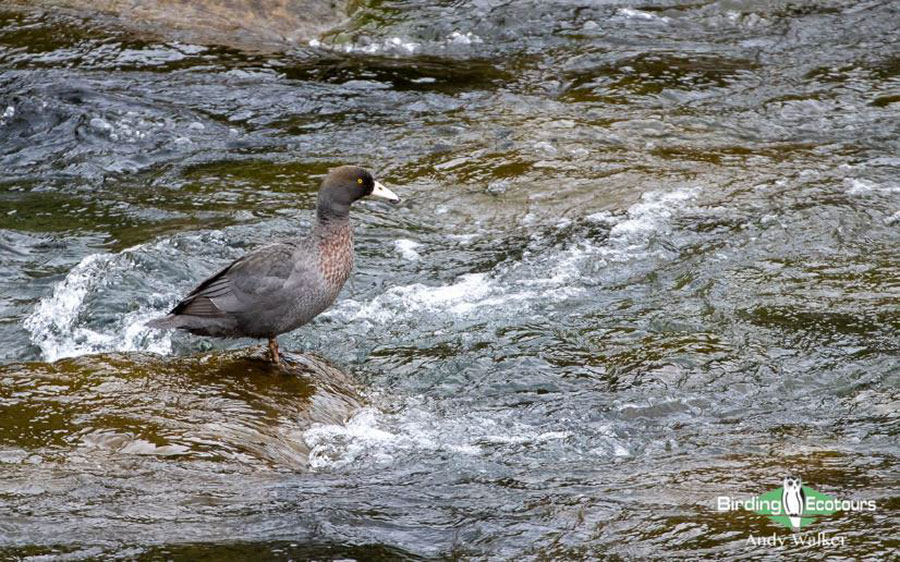
Blue Duck gave us some great views in a fast-flowing mountain river.
Nearing our accommodation in Tongariro National Park we called in at some fast-flowing streams where we found our big target, the rare and localized endemic, Blue Duck. While watching a pair of ducks we also found our first New Zealand Pipit and had further looks at an attractive Tomtit.
Day 6, 15th October 2022. Tongariro National Park to Kapiti Island
We awoke to a cold crisp morning and a spectacular view of snow-covered Mount Ngauruhoe and Mount Ruapehu. We took a drive up the mountain after breakfast to gain an even more spectacular view that even included Mount Taranaki bursting out of the clouds at Egmont National Park, some 254 kilometers (158 miles) away to the southwest! A couple of New Zealand Pipits were noted, but not a lot else, though the view was why we’d really come here. We started our journey down to the southwest of North Island and we called in at the Manawatu Estuary (some seeing Rook along the way). We had our lunch at the estuary where we saw Wrybill, New Zealand Plover, Double-banded Plover, Bar-tailed Godwit, Ruddy Turnstone, Red Knot, and Masked Lapwing. A flock of White-fronted Terns were rather flighty but gave some good views.
We arrived in Paraparaumu where we boarded our speedboat for a quick crossing to the idyllic Kapiti Island. During the remainder of the afternoon, we took a walk around a forested part of the island, finding our first Weka of the tour, along with plenty of other New Zealand/North Island endemics, such as New Zealand Kaka, Red-crowned Parakeet, New Zealand Pigeon, New Zealand Fantail, Tui, New Zealand Bellbird, Whitehead, North Island Saddleback, and North Island Robin. Watching a family of fantails provided lots of entertainment and won the “cute factor” award! A small wetland held a family of Brown Teal, along with Australasian Shoveler, Paradise Shelduck, Black Swan, Australasian Swamphen, and Pied Stilt.
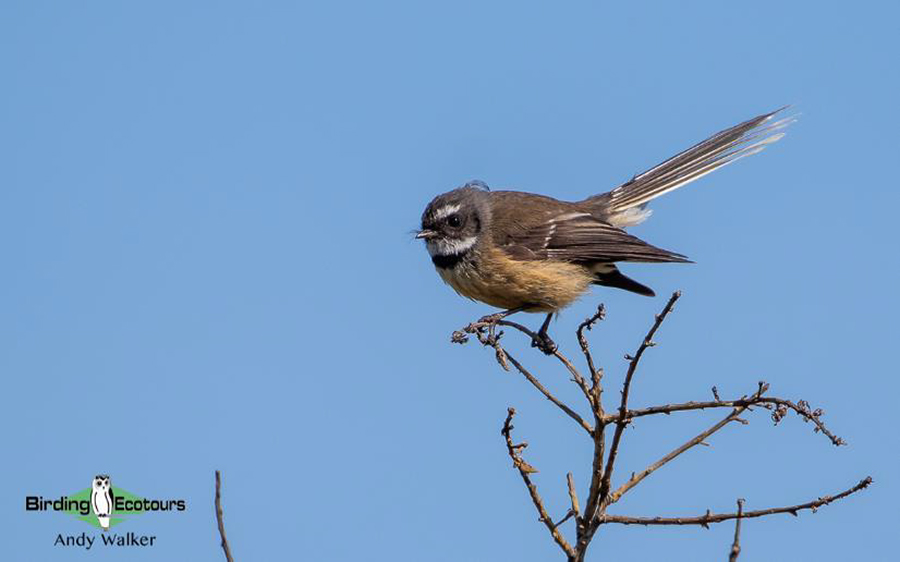
New Zealand Fantail is a common endemic but full of character and always a joy to watch. We had multiple opportunities throughout the tour to do as such.
After checking into our accommodation (to the sound of Pacific Long-tailed Cuckoo) we enjoyed some local snacks and wine with Weka on the balcony, and then dinner, before the main event, and main reason we’d come to stay on the island, a nocturnal kiwi walk. After an informative and interesting talk on the species, we spent about an hour walking around the area near the lodge and eventually all enjoyed views of a Little Spotted Kiwi or two, a fascinating species as are all kiwis. We also found Morepork, Little Penguin, and Weka during our nighttime excursion.
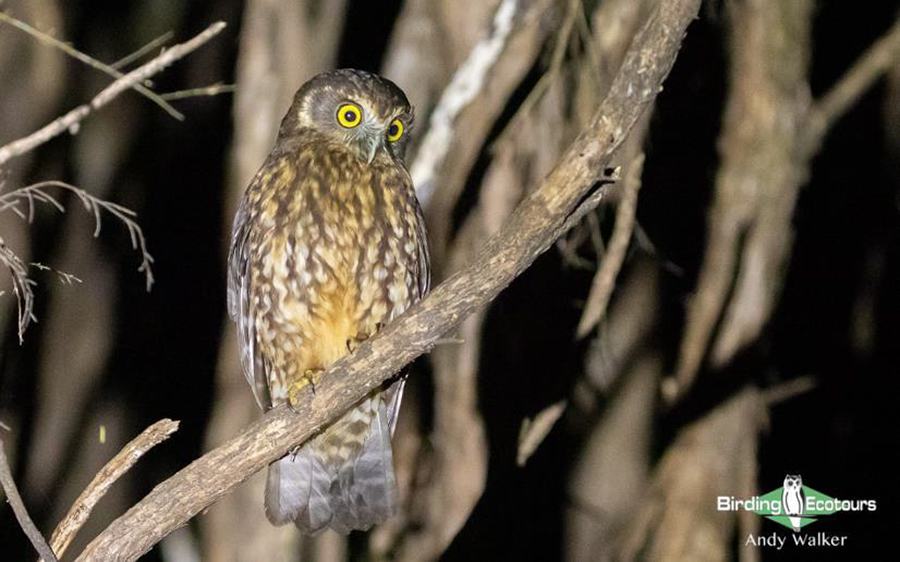
Morepork gave us some good views and was heard on many other occasions during the tour.
Day 7, 16th October 2022. Kapiti Island to Wellington then ferry to Picton, South Island.
We awoke to a cold start, and all stood in the sun warming up and drinking tea/coffee as we scanned the nearby hills, where a New Zealand Falcon was on view on and off for over an hour. It was great that everyone could finally catch up on this bird. Most of the birds seen/heard the previous day were still present, including Weka, Pacific Long-tailed Cuckoo, Sacred Kingfisher, Tui, Red-crowned Parakeet, New Zealand Kaka, and New Zealand Fantail.
After a delicious breakfast we took the boat back to Paraparaumu (seeing Pacific Reef Heron along the way). Back into our bus we then continued on to Otaki Sewage Works, where we found Black-fronted Dotterel as well as several duck species and lots of hybrids too. Afterwards, we drove into Wellington, New Zealand’s capital city for lunch at, and an exploration of, Te Papa Tongarewa (Museum of New Zealand) before catching the ferry to Picton, South Island. During the ferry crossing we saw lots of Fluttering Shearwaters, along with our first Westland Petrels of the trip, with Shy (White-capped) Albatross, Buller’s Albatross, Fairy Prion, and Sooty Shearwater also seen.
Day 8, 17th October 2022. Birding Marlborough Sound and Queen Charlotte Sound then travel to Kaikoura
We spent the morning cruising on a boat through Queen Charlotte Sound with a couple of major targets the main focus of our trip. As we left the marina, we were soon watching a pod of Dusky Dolphins, shortly after, as we commenced our journey proper, we were seeing lots of Fluttering Shearwaters, Australasian Gannets, White-fronted Tern, and both Kelp and Silver (Red-billed) Gulls. A rocky outcrop gave us great looks at our first main target of the day, New Zealand King Shag, one of the rarest shags in New Zealand. Here we also got our best looks so far at the attractive Spotted Shag as both stood side by side. We also enjoyed brief views of Little Penguin and prolonged views of New Zealand Fur Seal.
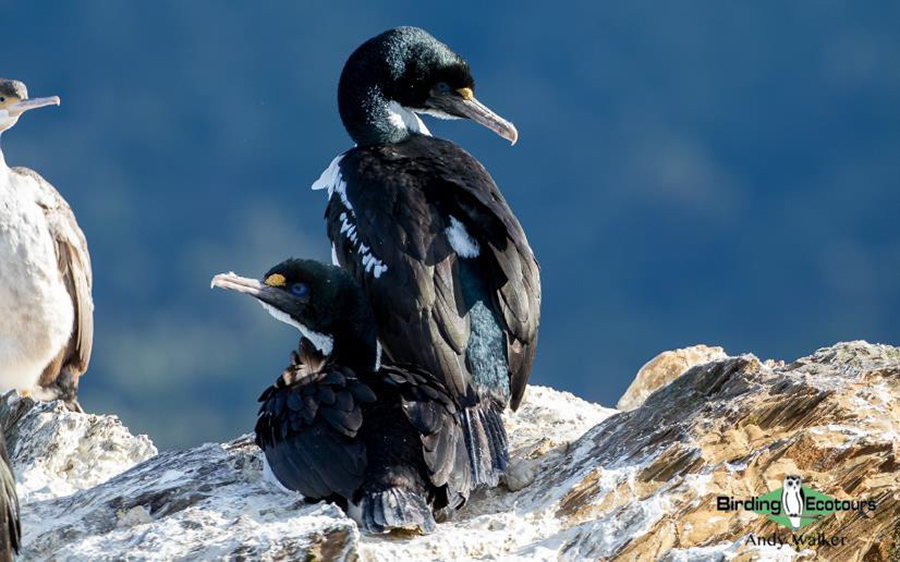
We enjoyed some close views of New Zealand King Shag while in Queen Charlotte Sound.
We made a wet landfall on Blumine Island, where we spent some time listening to, and looking at, a set of familiar birds and some new ones, the main target for us here was the Critically Endangered (BirdLife International) Malherbe’s Parakeet. We had a pair flying around as soon as we arrived, but it took longer to get the whole group to get good views of this rare parrot, but good views we did eventually get (see trip report cover image). South Island Saddleback was new for the trip, and we had a couple of very vocal birds. Tomtit was noted and we also saw New Zealand Bellbird, Tui, New Zealand Pigeon, and our best views so far of New Zealand Falcon.
After our morning on the water, it was time to drive south to Kaikoura, our base for the next two nights. We made a few stops along the way, one at a sewage works that gave us good views of a large flock of breeding plumaged Royal Spoonbills and a few other wildfowl species. Another stop at a small wetland gave us good views of Hoary-headed Grebe (uncommon recent natural colonizer in New Zealand), Great Crested Grebe, and Eurasian Coot. Driving along the coast into Kaikoura we stopped briefly at a New Zealand Fur Seal and Spotted Shag colony.
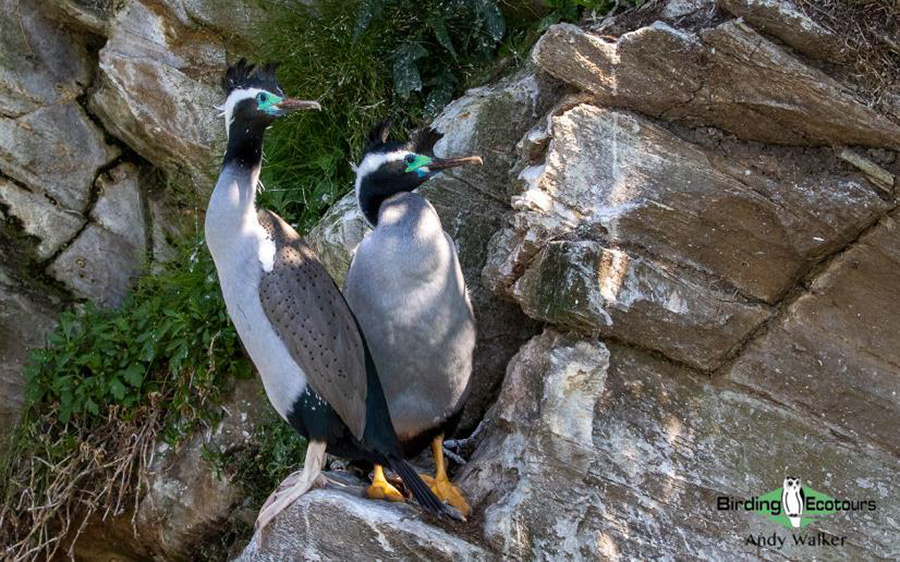
Spotted Shag is one seriously stunning bird when in breeding plumage.
Day 9, 18th October 2022. Kaikoura Pelagic birding trip
We spent the morning on an enjoyable pelagic trip off Kaikoura where we enjoyed a great selection of mammals and seabirds. As we left the harbor, we picked up a shy Hector’s Dolphin and a few White-fronted Terns. Moving out to sea, we noted a large number of Hutton’s Shearwaters cruising past us, with the occasional Sooty Shearwater included. As we progressed, we could see some large birds in the distance and before long we were watching both Westland Petrels and Cape Petrels. As we put out the burley (chum) in came some birds, and included the huge duo of Antipodean Albatross and Southern Royal Albatross. Here too we got some action from Salvin’s Albatross and Northern Giant Petrel, large birds but dwarfed by the former species.
We changed our direction after a while, in doing so we then picked up some distant Sperm Whales that we watched for a while. After putting out some more burley (chum) we were again inundated with seabirds. Along with the Antipodean Albatrosses, Southern Royal Albatrosses, and Salvin’s Albatrosses, we also now had several Shy (White-capped) Albatrosses in attendance and the numbers of Northern Giant Petrels was also increasing. A steady stream of Cape Petrels and Westland Petrels were coming in, along with a couple of Buller’s Shearwaters and Hutton’s Shearwaters. The views we were getting of all these birds was simply breathtaking as they sat off the back of the boat and squabbled over the food, a real tour highlight.
As we moved further out to sea we were suddenly upon a pod of Killer Whales (Orcas), we followed them for a while and got some great views of this most-wanted mammal. We ended our pelagic by watching a pod of Dusky Dolphins and numerous New Zealand Fur Seals.
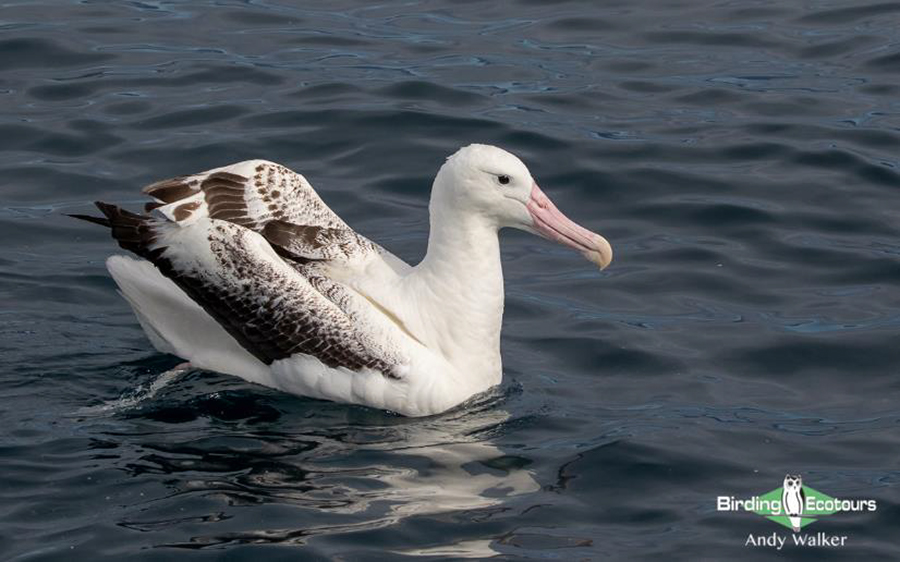
The humongous Southern Royal Albatross sat behind the boat and gave excellent views. This species has a wingspan of up to a whopping 142 inches (3.6 meters)!
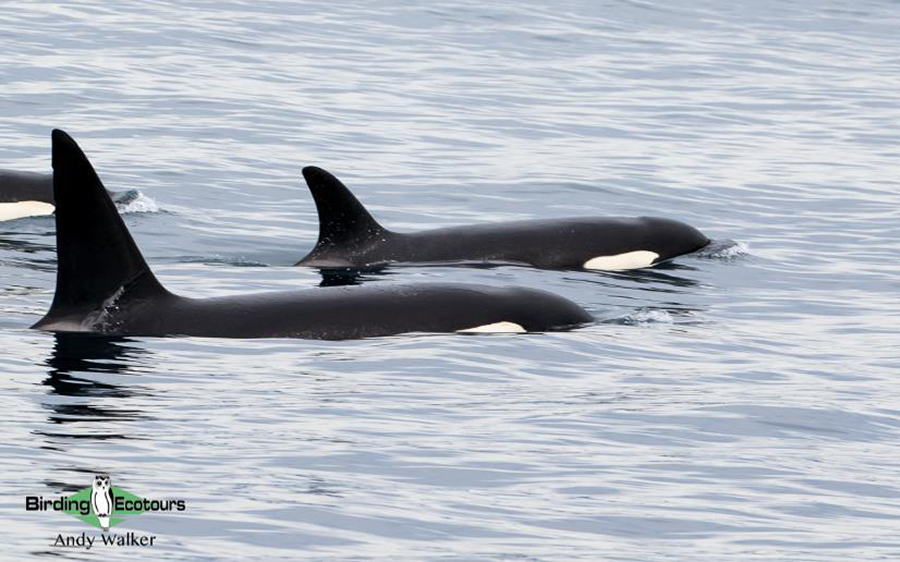
A large pod of Killer Whales (Orcas) provided another highlight of our morning on the sea off Kaikoura.
After our most enjoyable time on the sea, we came back to land for lunch. Some of the group took a hike around the headland during the afternoon, noting several species and some impressive scenery, and others took the opportunity to catch up on some rest and laundry!
Day 10, 19th October 2022. Kaikoura to Punakaiki via Arthur’s Pass
We had a long travel day today to get between Kaikoura on the east coast of South Island to Punakaiki on the west coast of South Island. We first drove south towards Christchurch where we stopped at Ashley River Estuary, here we found the Critically Endangered (BirdLife International) Black Stilt, one of the rarest shorebirds in the world, with an estimated population of 38-50 birds, and our first Black-fronted Terns of the trip. Plenty of other birds were present here too, including Wrybill, Double-banded Plover, Caspian Tern, White-fronted Tern, Royal Spoonbill, and Black-billed Gull. A couple of other roadside stops gave us a mix of common birds we’d previously seen, but that were still appreciated, including Yellowhammer and New Zealand Fantail.
Driving through Arthur’s Pass National Park we made a couple of stops to admire the impressive scenery as well as for some short birding sessions, one such stop produced the highly anticipated Rifleman (another “bird of the trip” possibility?), a tiny bird with a high-pitched call, along with our first Kea, Pipipi (New Zealand Brown Creeper) and South Island Robin of the tour.
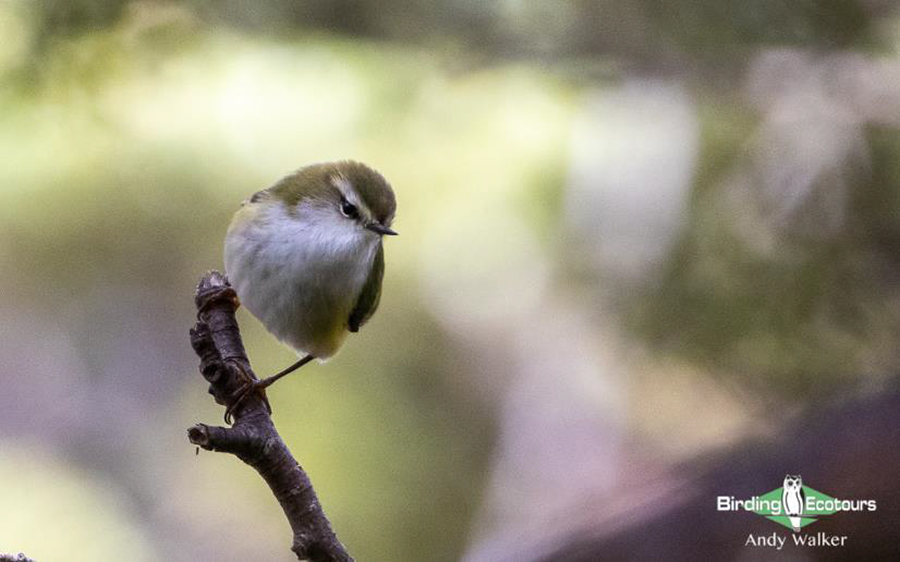
Rifleman, New Zealand’s smallest bird gave an excellent showing. The opposite end of the size spectrum to the Southern Royal Albatrosses we had been watching the previous day, this one is only 2.8 inches (7 centimeters) long and is an energetic ball of feathers!
We arrived at Punakaiki in the late afternoon. We checked into our hotel and had dinner before going out at night for a walk into the nearby hills where we got to witness the impressive sight (and sound) of several Westland Petrels returning to their nest burrows to feed their chicks, a fun experience indeed. We also heard the haunting calls of Pacific Long-tailed Cuckoo and Weka.
Day 11, 20th October 2022. Punakaiki to Franz Josef via Okarito Lagoon
We had a relaxed day with a later start after our previous nighttime excursion, travelling south down the west coast of South Island. We called in to check out the famous and impressive “pancake rocks” at Punakaiki as they were so close to our accommodation, here we enjoyed the natural landscape and some breeding White-fronted Terns. We then called in at Hokitika to take a look around the famous town and enjoyed a picnic lunch on the beach.
During the afternoon we visited Okarito Lagoon where we saw our first New Zealand Fernbird of the tour. We’d heard one earlier on the tour, but it was a rather windy day so little chance of seeing that one, today we found a sheltered spot and enjoyed great views of a pair. Here we also got our first and only Great Egrets of the tour (at the only location the species breeds in New Zealand), as well as several endemic bush birds, such as Tomtit, Tui, New Zealand Bellbird, New Zealand Fantail (including an interesting black morph bird), and Grey Gerygone.
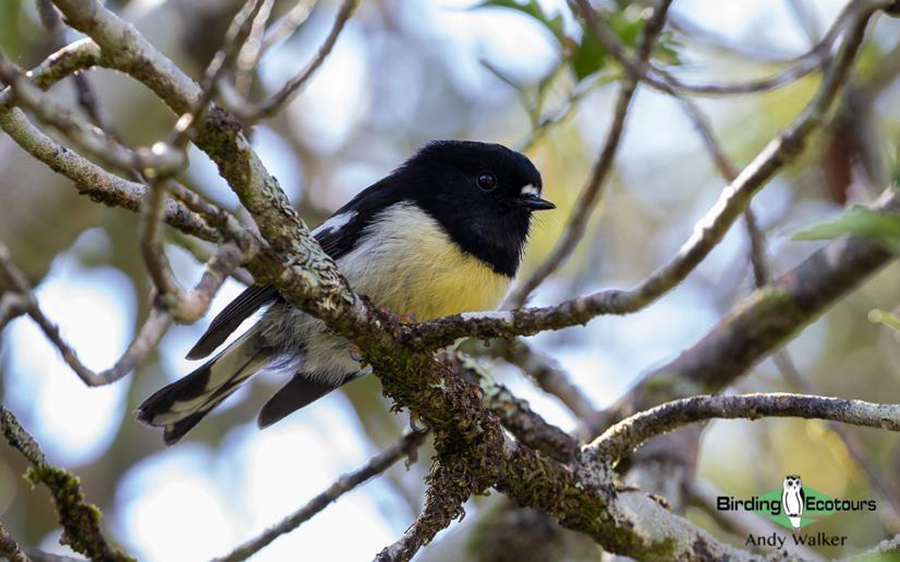
Some of the group got some excellent views of male Tomtit. The birds on South Island have orange/yellow on their breast, whereas those on North Island are white below.
In the evening we took a walk near Okarito Lagoon where we heard Okarito Kiwi, but they were too far into the bush to get to for views. We also heard Morepork and Pacific Long-tailed Cuckoo during our birding session.
Day 12, 21st October 2022. Franz Josef to Twizel via Haast Pass
A long day as we traveled from Franz Josef to Twizel. It was a long but spectacular journey through some staggering scenery. We took the route through Haast Pass and in doing so connected with the endemic Yellowhead during a brief tea/coffee/cake stop! Here we also got more looks at Rifleman as well as other more widespread endemics.
In the afternoon, after saying goodbye (and a huge thank you) to Richard, who had got prior eBird New Zealand Bird Atlas commitments, we called in at the Tasman Delta near Twizel. Here we got some good views of Black Stilt, closer than our earlier sighting and we also got to see Wrybill, Double-banded Plover, South Island Oystercatcher, and Black-fronted Tern all on their braided river breeding grounds and all set in front of spectacular snow-covered Mt Cook.
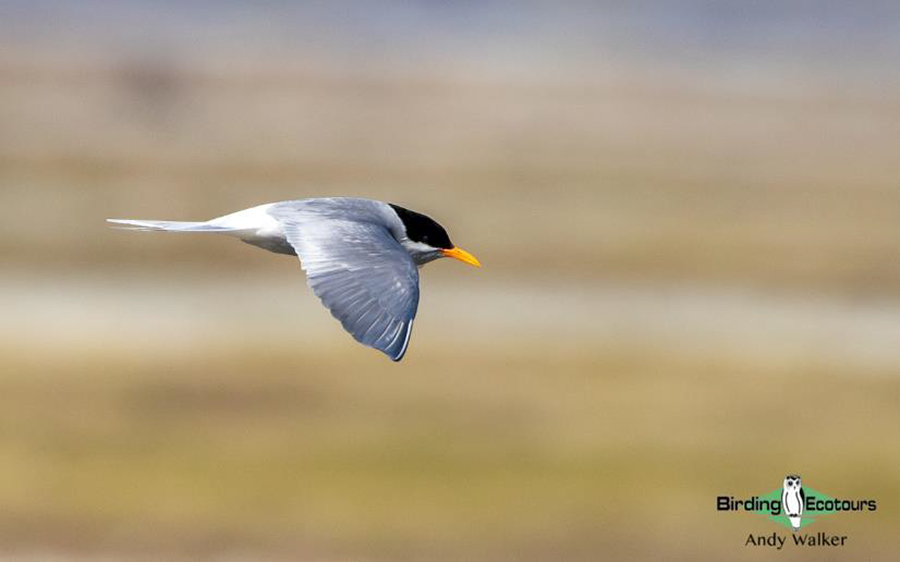
The endemic and attractive Black-fronted Tern was a popular bird with the group.
Day 13, 22nd October 2022. Twizel to Dunedin and Otago harbor cruise
We awoke to a very cold and frosty morning in Twizel. After breakfast we commenced our journey south to Dunedin. We called in at a lake near the town where we saw more waterbirds we’d seen earlier in the tour, such as Great Crested Grebe (these ones displaying though), New Zealand Scaup, and Black Swan.
Once we reached the coast we called in to the harbor at Oamaru where there was a huge Otago Shag colony. We noted the differences between the different color morphs of this localized species as well as the smaller Spotted Shags that were around the periphery of the colony. A mix of introduced finches proved an attractive distraction with Common Redpoll, European Goldfinch, European Greenfinch, and Common Chaffinch all giving good looks.
Once we arrived in Dunedin, we continued to the tip of the Otago peninsular. Here we joined a harbor cruise around Taiaroa Head where we soaked in the amazing sight of mainland breeding Northern Royal Albatrosses. The birds were up and down off their nesting area frequently giving close flight views, as well as sitting on the water off the boat undertaking their courtship and pair-bonding displays. Other species noted on the cruise included Otago Shag, Spotted Shag, Little Penguin, Sooty Shearwater, Royal Spoonbill, and New Zealand Sea Lion.
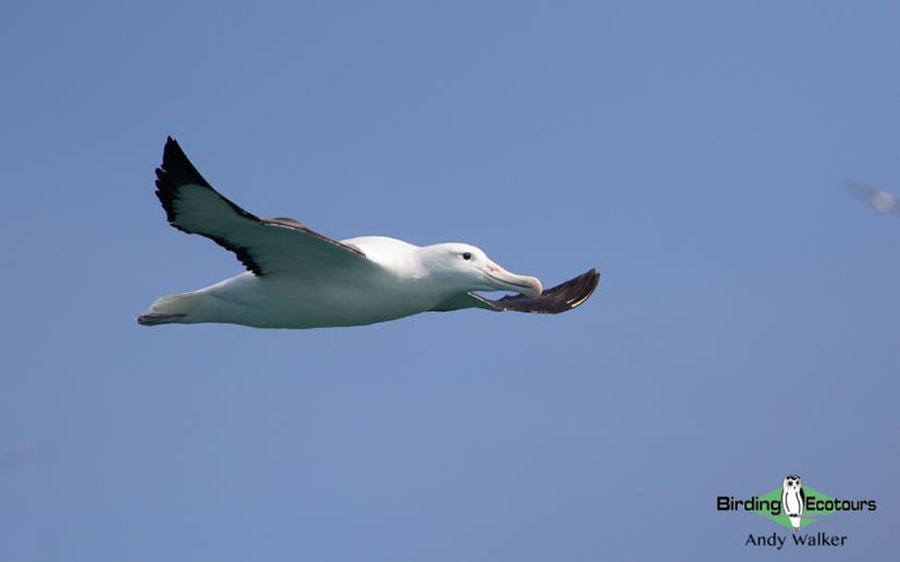
We were thrilled to watch the massive Northern Royal Albatrosses around their breeding colony on the Otago peninsular at Taiaroa Head.
Day 14, 23rd October 2022. Birding the south coast of South Island and travel to Oban, Stewart Island (Rakiura)
We spent the day driving from Dunedin down to Bluff on the southern tip of South Island and from Bluff we caught the fast ferry across to Oban on Stewart Island (Rakiura). Our first birding stop was at Nugget Point where we walked out to the lighthouse. In doing so we saw our first Shining Bronze Cuckoo of the trip (after hearing a few before now) and we also enjoyed our best view of the tour of New Zealand Falcon, with a hunting bird flying low below and then above us. Other interest was provided by a mix of native and introduced species, as well as the impressive coastal views. Moving on we called in to a beautiful bay for lunch where we saw New Zealand Sea Lion, and Greylag Goose (not quite as impressive!).
Continuing our journey during the afternoon we briefly had time to call into a wetland where a quick look gave us several shorebirds (Bar-tailed Godwit, South Island Oystercatcher, and Pied Stilt) and a range of wildfowl, such as Black Swan, Paradise Shelduck, New Zealand Scaup, Australasian Shoveler, and Grey Teal. In the late afternoon we took the ferry across to Stewart Island (Rakiura). Those braving the spray were rewarded with sightings of Fiordland Penguin, Foveaux Shag, Common Diving Petrel, and Salvin’s Albatross.
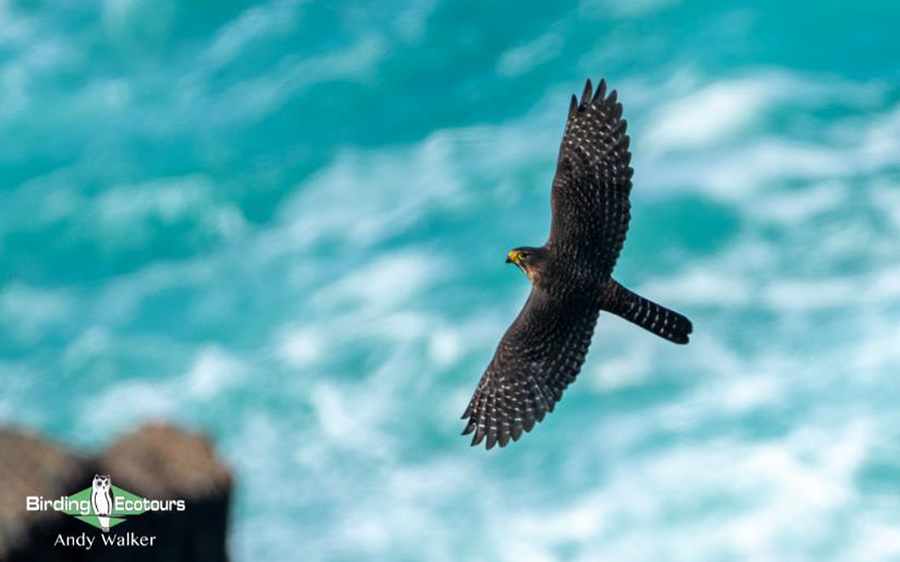
Trying to keep up with the fast-moving hunting New Zealand Falcon was tough!
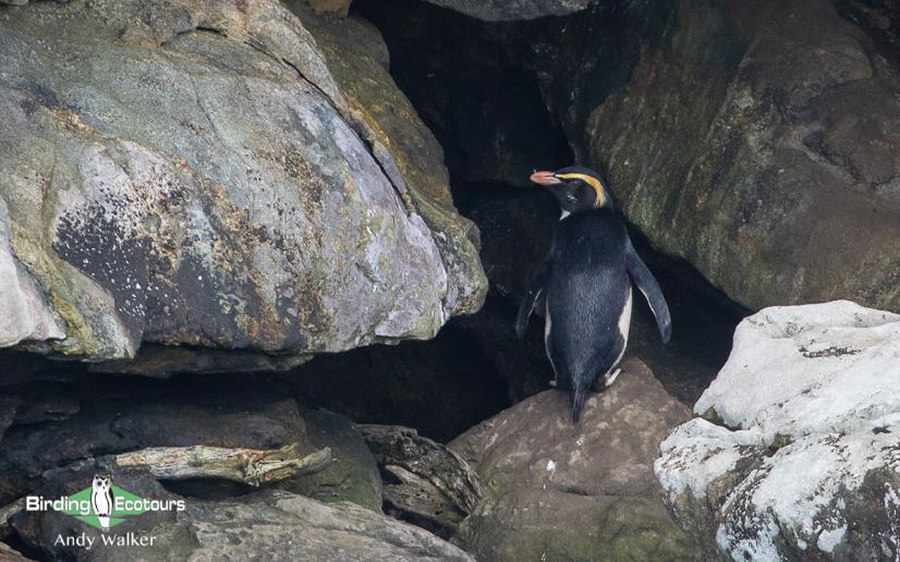
We had several Fiordland Penguin sightings during our time at and around Stewart Island (Rakiura) and later in the tour at Milford Sound too.
Day 15, 24th October 2022. Stewart Island (Rakiura) Pelagic trip and birding Ulva Island
We awoke to a rather damp and dull morning after a heavy rainstorm during the early hours, which was still lingering while we were having breakfast. This poor weather would stay with us for most of the morning, but it didn’t really impact us too much, thankfully.
We met our pelagic boat outside our hotel after breakfast and set out to explore some of the water and small islands off Stewart Island (Rakiura). Our first stop was not far out of the harbor where we saw Fiordland Penguin near to where we had seen them the previous evening, much better views for everyone this time. Moving out to sea we enjoyed a range of pelagic species, many of them giving great views as they came in to eat our burley (chum), such as Buller’s Albatross, Shy (White-capped) Albatross, Salvin’s Albatross, Northern Giant Petrel, Common Diving Petrel, Cook’s Petrel, Sooty Shearwater, and Fairy Prion. Checking out some of the smaller islets we found both Little Penguin and a major target, Yellow-eyed Penguin. We also visited a Foveaux Shag colony and gained good views of many birds on their nests.
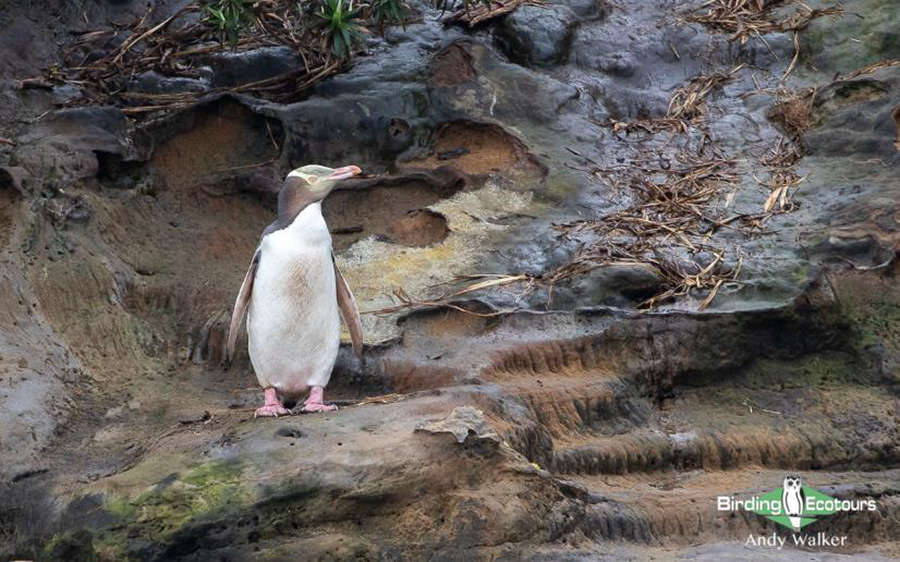
We were rather excited to see this Yellow-eyed Penguin during our boat trip.
After lunch on the boat, we got dropped off on pretty Ulva Island where we spent a few hours soaking in a range of endemic birds. Noisy New Zealand Kaka greeted us, along with Weka, New Zealand Fantail, and South Island Robin. As we quietly walked through the forested island, we picked up Red-crowned Parakeet, Yellow-crowned Parakeet, Tui, New Zealand Bellbird, and Grey Gerygone, as well as more Weka, New Zealand Kaka, and South Island Robins. A quick scan of a beach provided us with looks at Variable Oystercatcher, Kelp Gull, Weka, and Silver (Red-billed) Gull. Continuing our walk on the island we came across a family group of South Island Saddlebacks alarm calling at the presence of a New Zealand Kaka and a short while later we found a good mixed flock (bird wave) containing many of the aforementioned species, as well as Yellowhead, Pipipi (New Zealand Brown Creeper), and New Zealand Pigeon. A fitting end to another great day of birding in New Zealand… or was it…
An evening excursion after dinner resulted in everyone in the group getting multiple Southern Brown Kiwi sightings, including one bird that gave prolonged views, and possibly became a “bird of the Trip” contender.
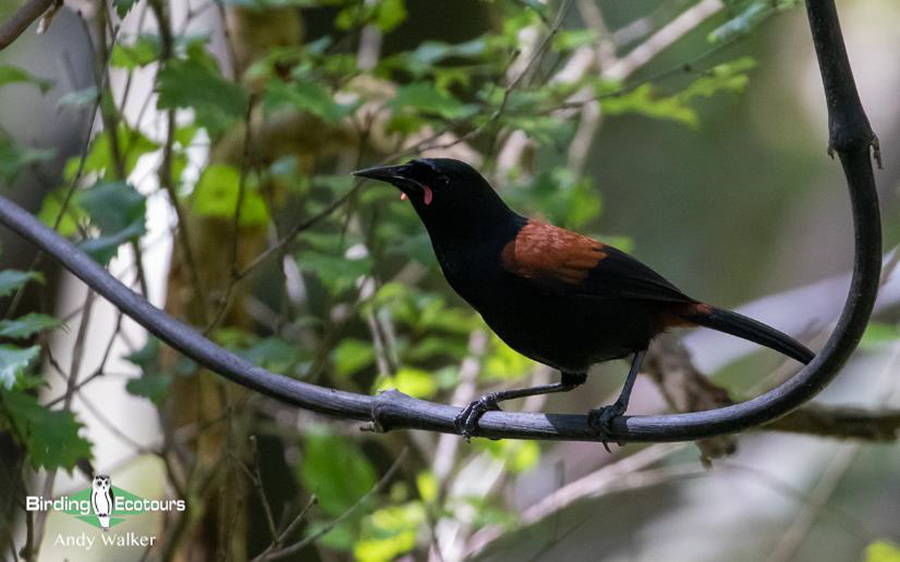
South Island Saddleback very nearly became extinct after rats invaded the final three islands the species was clinging onto in the mid-1960’s. Luckily birds were translocated to predator-free island refuges where they were able to survive.
Day 16, 25th October 2022. Stewart Island (Rakiura) to Te Anau
A relaxed day as we travelled between Oban on Stewart Island (Rakiura) to Bluff on South Island, before driving west along the picturesque coast, then north into some equally spectacular scenery to Te Anau, on the edge of Fiordland National Park. The sea crossing was flat and as a result seabirds were hard to come by, though Buller’s Albatross, Shy (White-capped) Albatross, Brown Skua, Cape Petrel, Sooty Shearwater, and Common Diving Petrel were all recorded.
Once back on South Island we called in at a few wetland sites where we picked up many of the birds we had seen before on the tour, such as Paradise Shelduck, Australasian Shoveler, Great Cormorant, Bar-tailed Godwit, South Island Oystercatcher, and Ruddy Turnstone, etc.
We called into a very pretty coastal bay for lunch, where we had a constant stream of Sooty Shearwaters passing by, along with Northern Giant Petrel, Australasian Gannet, White-fronted Tern, Spotted Shag, and Foveaux Shag. On arrival at Te Anau, some of the group opted to walk along the lake shore and do some gift shopping, while others visited the nearby Te Anau Caves for a glowworm tour!
Day 17, 26th October 2022. Birding Milford Sound and Homer Tunnel
Departing Te Anau after breakfast we first called in at a lakeside viewpoint where we watched some New Zealand Scaup foraging as well as a pair of New Zealand Fantails and a vocal South Island Robin.
Moving on to a woodland patch, we commenced a loop walk through some spectacular mossy forest. Along the walk we enjoyed seeing several Rifleman as well as more showy New Zealand Fantails, South Island Robins, New Zealand Kaka, and a few other native birds. Weather conditions were not ideal for birding with a very strong wind and increasing rainfall, but we still made the most of our time and certainly weren’t going to complain after the wonderful weather we had enjoyed for most of the tour.
Gaining some elevation we came across our first Kea for the day, and shortly later another few materialized and we enjoyed watching this comical alpine endemic parrot, as we tried to prevent them destroying our vehicle. Needless to say, we had our best views of this species of the tour here!
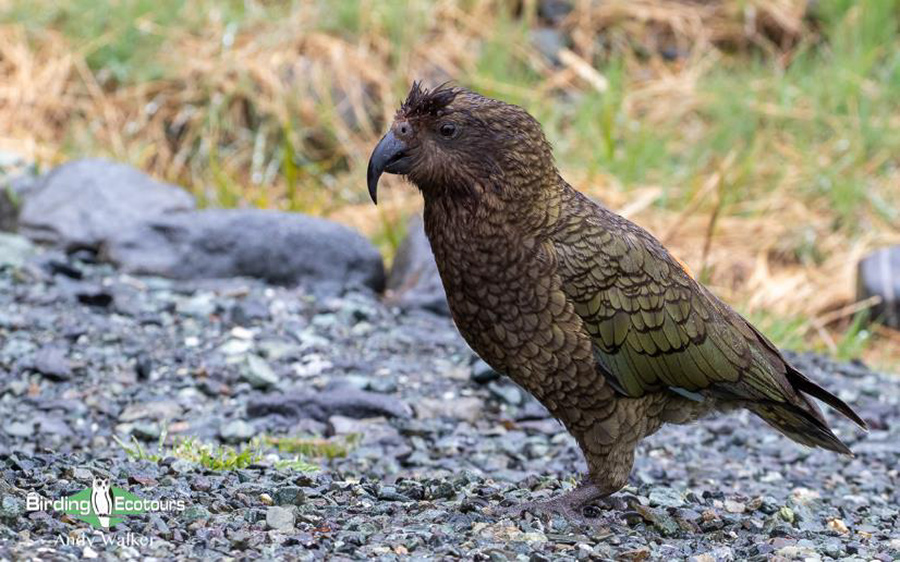
We were visited by a few mischievous Kea during our time birding around the Milford Sound area, which was a real treat, they are fascinating birds.
After a picnic lunch in the bus sheltering from the rain, we started walking around some boulder fields near Homer Tunnel – a formidable and impressive landscape, as much of the area is here. In no time at all we were watching a pair of the fantastic New Zealand Rockwren. We didn’t really care that it was cold and raining because this was one of the top endemic targets for many on the trip and we were very pleased to get such good views in limited time of what can be a tricky bird to connect with at times.
After a warming cup of tea, coffee, or hot chocolate, and a snack, the group set out on a boat trip on Milford Sound where Fiordland Penguin was the pick of the birds seen in some spectacular glacial scenery. Some of the group also saw the Critically Endangered (IUCN) Fiordland subpopulation of Common Bottlenose Dolphin.
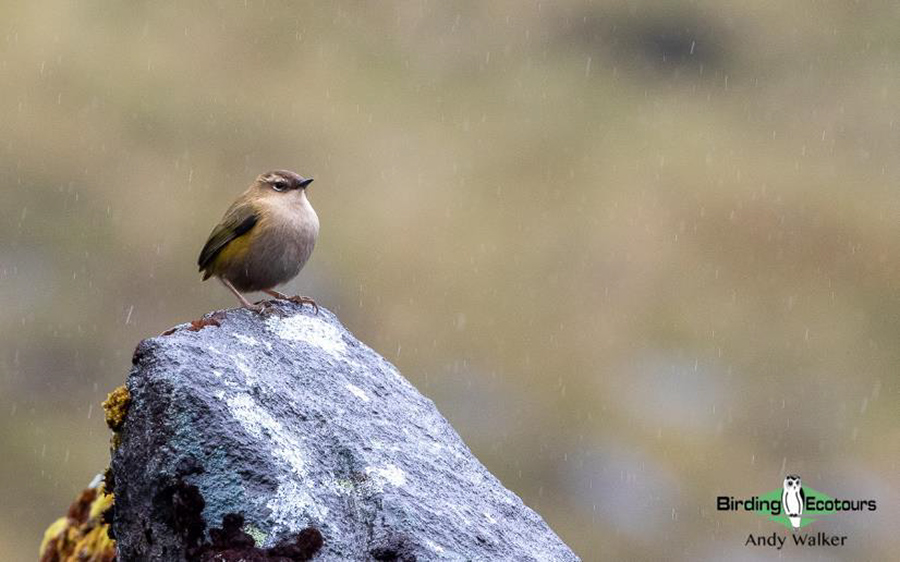
The endemic New Zealand Rockwren performed excellently for us in the cold rain.
Day 18, 27th October 2022. Te Anau to Dunedin where tour concluded
We left Te Anau after breakfast and made the drive back to Dunedin airport, where this thoroughly enjoyable tour concluded. There was lots of discussion about “bird of the trip” along the journey and Southern Brown Kiwi was voted “bird of the trip”, but had close competition from many other species, such as Little Spotted Kiwi, Stitchbird, Weka, Fluttering Shearwater, Little Penguin, Yellow-eyed Penguin, Yellowhead, New Zealand Fantail, New Zealand Falcon, and New Zealand Rockwren.
We must offer up a huge thank you to Mark who guided the tour throughout (and who carefully drove us around the islands) and to Richard, who was along for most of the tour too. It was a pleasure birding and traveling with you both and we learnt so much about the birds, wildlife, landscape, geology, habitats, and flora of New Zealand, and had a great laugh along the way too. From pelagic boat trips, predator-free small-island visits, nighttime kiwi walks, stunning snow-capped mountains, braided river valleys, and mossy forests we covered a lot of ground through this beautiful country. I look forward to traveling with you on our next New Zealand birding tour.
A huge thank you to everyone in the group too, for contributing to making the tour a great success, I look forward to traveling with you all again soon, hope to see you in Borneo, Thailand, PNG, or Bali soon!
Bird List – Following IOC (12.2)
The following notation after species names is used to show conservation status following BirdLife International: CR = Critically Endangered, EN = Endangered, VU = Vulnerable. The common name for New Zealand endemics is shown in bold type, e.g., Southern Brown Kiwi.
| Common Name | Scientific Name |
| Kiwis (Apterygidae) | |
| Southern Brown Kiwi – VU | Apteryx australis |
| North Island Brown Kiwi – VU | Apteryx mantelli |
| Okarito Kiwi – VU (H) | Apteryx rowi |
| Little Spotted Kiwi | Apteryx owenii |
| Ducks, Geese, Swans (Anatidae) | |
| Canada Goose | Branta canadensis |
| Greylag Goose | Anser anser |
| Black Swan | Cygnus atratus |
| Blue Duck – EN | Hymenolaimus malacorhynchos |
| Paradise Shelduck | Tadorna variegata |
| Australasian Shoveler | Spatula rhynchotis |
| Pacific Black Duck | Anas superciliosa |
| Mallard | Anas platyrhynchos |
| Grey Teal | Anas gracilis |
| Brown Teal | Anas chlorotis |
| New Zealand Scaup | Aythya novaeseelandiae |
| New World Quail (Odontophoridae) | |
| California Quail | Callipepla californica |
| Pheasants & Allies (Phasianidae) | |
| Wild Turkey | Meleagris gallopavo |
| Common Pheasant | Phasianus colchicus |
| Brown Quail | Synoicus ypsilophorus |
| Cuckoos (Cuculidae) | |
| Pacific Long-tailed Cuckoo | Urodynamis taitensis |
| Shining Bronze Cuckoo | Chrysococcyx lucidus |
| Pigeons, Doves (Columbidae) | |
| Rock Dove (Feral Pigeon) | Columba livia dom. |
| African Collared Dove (Barbary Dove) | Streptopelia roseogrisea dom. |
| Spotted Dove | Spilopelia chinensis |
| New Zealand Pigeon | Hemiphaga novaeseelandiae |
| Rails, Crakes & Coots (Rallidae) | |
| Weka – VU | Gallirallus australis |
| Buff-banded Rail | Hypotaenidia philippensis |
| Eurasian Coot | Fulica atra |
| Australasian Swamphen | Porphyrio melanotus |
| Grebes (Podicipedidae) | |
| Hoary-headed Grebe | Poliocephalus poliocephalus |
| New Zealand Grebe | Poliocephalus rufopectus |
| Great Crested Grebe | Podiceps cristatus |
| Oystercatchers (Haematopodidae) | |
| South Island Oystercatcher | Haematopus finschi |
| Variable Oystercatcher | Haematopus unicolor |
| Stilts, Avocets (Recurvirostridae) | |
| Pied Stilt | Himantopus leucocephalus |
| Black Stilt – CR | Himantopus novaezelandiae |
| Plovers (Charadriidae) | |
| Masked Lapwing | Vanellus miles |
| Wrybill – VU | Anarhynchus frontalis |
| Pacific Golden Plover | Pluvialis fulva |
| New Zealand Plover | Charadrius obscurus |
| Double-banded Plover | Charadrius bicinctus |
| Black-fronted Dotterel | Elseyornis melanops |
| Sandpipers, Snipes (Scolopacidae) | |
| Bar-tailed Godwit | Limosa lapponica |
| Black-tailed Godwit | Limosa limosa |
| Ruddy Turnstone | Arenaria interpres |
| Red Knot | Calidris canutus |
| Sharp-tailed Sandpiper | Calidris acuminata |
| Curlew Sandpiper | Calidris ferruginea |
| Gulls, Terns, Skimmers (Laridae) | |
| Silver Gull | Chroicocephalus novaehollandiae |
| Black-billed Gull | Chroicocephalus bulleri |
| Kelp Gull | Larus dominicanus |
| Caspian Tern | Hydroprogne caspia |
| White-fronted Tern | Sterna striata |
| Black-fronted Tern – EN | Chlidonias albostriatus |
| Skuas (Stercorariidae) | |
| Brown Skua | Stercorarius antarcticus |
| Penguins (Spheniscidae) | |
| Little Penguin | Eudyptula minor |
| Yellow-eyed Penguin – EN | Megadyptes antipodes |
| Fiordland Penguin | Eudyptes pachyrhynchus |
| Austral Storm Petrels (Oceanitidae) | |
| White-faced Storm Petrel | Pelagodroma marina |
| Albatrosses (Diomedeidae) | |
| Antipodean Albatross | Diomedea antipodensis |
| Southern Royal Albatross – VU | Diomedea epomophora |
| Northern Royal Albatross – EN | Diomedea sanfordi |
| Shy Albatross | Thalassarche cauta |
| Salvin’s Albatross – VU | Thalassarche salvini |
| Buller’s Albatross | Thalassarche bulleri |
| Petrels, Shearwaters, Diving Petrels (Procellariidae) | |
| Northern Giant Petrel | Macronectes halli |
| Cape Petrel | Daption capense |
| Fairy Prion | Pachyptila turtur |
| Cook’s Petrel – VU | Pterodroma cookii |
| Westland Petrel – EN | Procellaria westlandica |
| Buller’s Shearwater – VU | Ardenna bulleri |
| Sooty Shearwater | Ardenna grisea |
| Flesh-footed Shearwater | Ardenna carneipes |
| Fluttering Shearwater | Puffinus gavia |
| Hutton’s Shearwater – EN | Puffinus huttoni |
| Little Shearwater | Puffinus assimilis |
| Common Diving Petrel | Pelecanoides urinatrix |
| Gannets, Boobies (Sulidae) | |
| Australasian Gannet | Morus serrator |
| Cormorants, Shags (Phalacrocoracidae) | |
| Little Pied Cormorant | Microcarbo melanoleucos |
| Spotted Shag | Phalacrocorax punctatus |
| Australian Pied Cormorant | Phalacrocorax varius |
| Little Black Cormorant | Phalacrocorax sulcirostris |
| Great Cormorant | Phalacrocorax carbo |
| New Zealand King Shag – VU | Leucocarbo carunculatus |
| Otago Shag – VU | Leucocarbo chalconotus |
| Foveaux Shag | Leucocarbo stewarti |
| Ibises, Spoonbills (Threskiornithidae) | |
| Royal Spoonbill | Platalea regia |
| Herons, Bitterns (Ardeidae) | |
| Australasian Bittern – EN (H) | Botaurus poiciloptilus |
| Eastern Cattle Egret | Bubulcus coromandus |
| Great Egret | Ardea alba |
| White-faced Heron | Egretta novaehollandiae |
| Pacific Reef Heron | Egretta sacra |
| Kites, Hawks, Eagles (Accipitridae) | |
| Swamp Harrier | Circus approximans |
| Owls (Strigidae) | |
| Morepork | Ninox novaeseelandiae |
| Kingfishers (Alcedinidae) | |
| Sacred Kingfisher | Todiramphus sanctus |
| Caracaras, Falcons (Falconidae) | |
| New Zealand Falcon | Falco novaeseelandiae |
| New Zealand Parrots (Strigopidae) | |
| Kea – EN | Nestor notabilis |
| New Zealand Kaka – EN | Nestor meridionalis |
| Old World Parrots (Psittaculidae) | |
| Eastern Rosella | Platycercus eximius |
| Yellow-crowned Parakeet | Cyanoramphus auriceps |
| Malherbe’s Parakeet – CR | Cyanoramphus malherbi |
| Red-crowned Parakeet | Cyanoramphus novaezelandiae |
| New Zealand Wrens (Acanthisittidae) | |
| Rifleman | Acanthisitta chloris |
| New Zealand Rockwren – EN | Xenicus gilviventris |
| Honeyeaters (Meliphagidae) | |
| Tui | Prosthemadera novaeseelandiae |
| New Zealand Bellbird | Anthornis melanura |
| Australasian Warblers (Acanthizidae) | |
| Grey Gerygone | Gerygone igata |
| New Zealand Wattlebirds (Callaeidae) | |
| North Island Kokako | Callaeas wilsoni |
| North Island Saddleback | Philesturnus rufusater |
| South Island Saddleback | Philesturnus carunculatus |
| Stitchbird (Notiomystidae) | |
| Stitchbird – VU | Notiomystis cincta |
| Woodswallows, Butcherbirds & Allies (Artamidae) | |
| Australian Magpie | Gymnorhina tibicen |
| Whiteheads (Mohouidae) | |
| Yellowhead – EN | Mohoua ochrocephala |
| Whitehead | Mohoua albicilla |
| Pipipi | Mohoua novaeseelandiae |
| Fantails (Rhipiduridae) | |
| New Zealand Fantail | Rhipidura fuliginosa |
| Crows, Jays (Corvidae) | |
| Rook | Corvus frugilegus |
| Australasian Robins (Petroicidae) | |
| Tomtit | Petroica macrocephala |
| North Island Robin | Petroica longipes |
| South Island Robin | Petroica australis |
| Larks (Alaudidae) | |
| Skylark | Alauda arvensis |
| Swallows, Martins (Hirundinidae) | |
| Welcome Swallow | Hirundo neoxena |
| Grassbirds & Allies (Locustellidae) | |
| New Zealand Fernbird | Poodytes punctatus |
| White-eyes (Zosteropidae) | |
| Silvereye | Zosterops lateralis |
| Starlings, Rhabdornis (Sturnidae) | |
| Common Myna | Acridotheres tristis |
| Common Starling | Sturnus vulgaris |
| Thrushes (Turdidae) | |
| Song Thrush | Turdus philomelos |
| Common Blackbird | Turdus merula |
| Old World Sparrows, Snowfinches (Passeridae) | |
| House Sparrow | Passer domesticus |
| Accentors (Prunellidae) | |
| Dunnock | Prunella modularis |
| Wagtails, Pipits (Motacillidae) | |
| New Zealand Pipit | Anthus novaeseelandiae |
| Finches, Euphonias (Fringillidae) | |
| Common Chaffinch | Fringilla coelebs |
| European Greenfinch | Chloris chloris |
| Common Redpoll | Acanthis flammea |
| European Goldfinch | Carduelis carduelis |
| Buntings (Emberizidae) | |
| Yellowhammer | Emberiza citrinella |
| Total seen | 134 |
| Total heard only | 2 |
| Total recorded | 136 |
Mammal List
| Common Name | Scientific Name |
| Rorquals (Balaenopteridae) | |
| Bryde’s Whale | Balaenopterta edeni brydei |
| (Southern) Humpback Whale | Megaptera novaeangliae australis |
| Sperm Whales (Physeteridae) | |
| Sperm Whale | Physeter macrocephalus |
| Oceanic Dolphins (Delphinidae) | |
| Killer Whale (Orca) | Orcinus orca |
| Dusky Dolphin | Sagmatias obscurus |
| (South Island) Hector’s Dolphin | Cephalorhynchus hectori hectori |
| Common (Fiordland subpopulation) Bottlenose Dolphin | Tursiops truncates (Fiordland subpopulation) |
| Eared Seals (Otariidae) | |
| New Zealand Fur Seal | Arctocephalus forsteri |
| New Zealand Sea Lion | Phocarctos hookeri |
| Hairs and Rabbits (Leporidae) | |
| European Rabbit | Oryctolagus cuniculus |
| Brown Hare | Lepus europaeus |
| Deer (Cervidae) | |
| White-tailed Deer | Odocoileus virginianus |
| Total | 12 |
Reptile List
| Common Name | Scientific Name |
| Australasian Geckos (Diplodactylidae) | |
| Common (Raukawa) Gecko | Woodworthia maculata |
| Skinks (Scincidae) | |
| New Zealand Grass Skink | Oligosoma polychroma |
| Tuataras (Sphenodontidae) | |
| Tuatara | Sphenodon punctatus |
| Total | 3 |
Amphibians List
| Common Name | Scientific Name |
| Australian Tree Frogs (Pelodryadidae) | |
| Southern Bell Frog | Ranoidea raniformis |
| Green and Golden Bell Frog | Ranoidea aurea |
| Total | 2 |
Notable Other Taxa List
| Common Name | Scientific Name |
| Wētā and King Crickets (Anostostomatidae) | |
| Auckland Tree Wētā | Hemideina thoracica |
| Wētāpunga | Deinacrida heteracantha |
| Lady Beetles (Coccinellidae) | |
| Steelblue Lady Beetle | Halmus chalybeus |
| Whites, Yellows, and Sulphurs (Pieridae) | |
| Small White | Pieris rapae |
| Brush-footed Butterflies (Nymphalidae) | |
| Monarch | Danaus plexippus |
| New Zealand Red Admiral | Vanessa gonerilla |
| Freshwater Eels (Anguillidae) | |
| New Zealand Longfin Eel | Anguilla dieffenbachii |
| Total | 7 |
This is a sample trip report. Please email us ([email protected]) for more trip reports from this destination.
